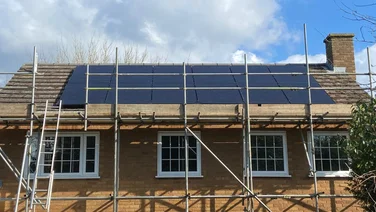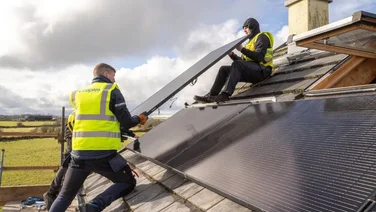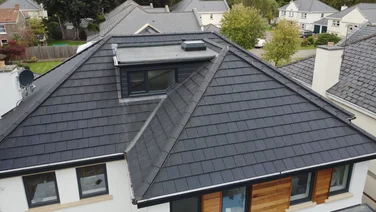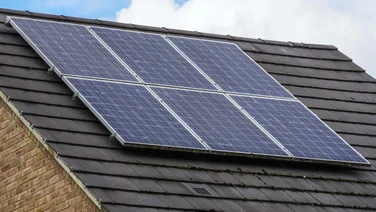- Thin-film solar panels are much more flexible than ordinary solar panels
- They’re typically less efficient than other solar panel types
- A 4 kilowatt thin-film solar panel system will cost around £4,160
Thin-film solar panels are one of many different types of solar panels that can help cut costs and emissions. They have been around for more than four decades – and they’re more accessible than ever.
Their thinness gives them a unique advantage over standard solar panels, though that doesn’t mean they’re perfect.
We’ve created this complete guide on thin-film solar panels to give you everything you need to know about them.
Where do you want to install solar panels?
Get started
What are thin-film solar panels?
Thin-film solar panels are exactly what they sound like — much thinner versions of the solar panels you’re familiar with.
What makes them different is not only how thin they are, it’s how their size allows them to be far more flexible than ordinary solar panels.
For example, thin-film solar panels are perfect for use in building-integrated photovoltaics (BIPVs). This is where you integrate solar technology into objects like roof slates, roof shingles, or cutting-edge technology like solar windows.
They’ve been used on vehicles, boat decks, and even in space, where their lightweight nature makes them well suited for powering satellites.
How are thin-film solar panels created?
Thin-film solar panels are made up of several layers of photovoltaic (PV) materials, which include:
- Amorphous silicon
- Cadmium telluride
- Copper indium gallium selenide
- Organic PV cells
Efficiency differs between the materials above, so sometimes you can use just a single layer of material. The layer or layers are then placed over a glass, plastic, or metal surface.
However, monocrystalline and polycrystalline silicon cells can’t be used. These are the two main types of materials used in ordinary solar panels, but they’re too thick to be used in thin-film solar cells.
How big are thin-film solar panels?
Thin-film solar panels range from tens of micrometres, to mere nanometres.
For context, you can fit 1,000 micrometres into a single millimetre, and 1,000 nanometres into a single micrometre. We’re almost in the second dimension here.
And you can make thin-film solar panels as wide as you need. Anything is possible, from powering a simple calculator to covering acres of space.
How efficient are thin-film solar panels?
Most thin-film solar panels are less efficient than mono and polycrystalline solar panels. Their efficiency rating is 7–13%, which is a fair bit lower than the 18–22% seen in modern, monocrystalline solar panels.
Lab experiments have brought the efficiency of thin-film solar cells up to 21.7%, but at the moment these aren’t commercially available.
Where do you want to install solar panels?
Get startedHow much do thin-film solar panels cost?
You’ll pay around £1.04 per watt for thin-film solar panels, or roughly £6,240 for a 6 kW system. That’s cheaper than the cost of a 4 kW solar panel system, which will typically set you back £6,500.
The problem is that thin-film solar panels take up more space, because with a lower efficiency rating, you need more coverage to generate a similar amount of electricity.
Here’s a table showing the typical costs of thin-film solar panel systems:

Is your home suitable for thin-film solar panels?
Your home is probably suitable for thin-film solar panels, but their lower efficiency means a lot of properties won’t be able to generate enough electricity to replace or significantly reduce grid dependency.
Assuming your thin-film solar panels have an efficiency rating of 10%, you would need 50% more roof space to achieve the same power output of a standard solar panel system with a 20% efficiency rating.
Put another way, a 4 kW solar panel system would need 28 square metres (m²) of roof space, whereas a 4 kW thin-film solar panel system would require 42 m².
However, thin-film solar panels have one key advantage: they work better at more extreme angles. In fact, you can even use them vertically, although this might not be that visually appealing.
It’s also worth noting that you can mount solar panels onto sheds or in gardens.
According to solar panel manufacturer Heliatek, thin-film solar panels are “extremely flexible, making suitable for architectural surfaces, meaning all non-flat surfaces.”
Pros and cons of thin-film solar panels
Solar panels can also increase the value of your property since more and more people want homes with solar panels.
Our National Home Energy Survey found that 69% of Brits would buy property with solar panels, up from 65% last year.
According to Heliatek, the biggest advantage is the lighter weight, which is also associated with less material and resources usage.
“Weight plays a role everywhere, for example, where the load capacity of an old roof would not allow a normal solar system,” the company told The Eco Experts.
How are thin-film solar panels installed?
You can install thin-film solar panels in much the same way as an ordinary solar array. The major difference is you can install them on more surfaces, such as on caravans and boats.
Also, because they’re so light, you don’t need the same structural support you would for a normal solar panel system. You can effectively roll thin-film solar panels out like a carpet, then the installer just needs to connect them to the inverter.
It’s easier to install thin-film solar panels than regular models, but because of the electrical know-how required to get them working properly, we will always recommend using a professional.
Can you buy thin-film solar panels in the UK?
You can buy thin-film solar panels in the UK, but as they’re not as common as standard solar panels, you should expect the process of finding an installer to take longer.
Here are a few companies that provide thin-film solar panels.
Midsummer Energy
Midsummer Energy sells a range of thin-film solar panels, from 70 watts up to 500 watts.
Prices start at £185 for its 70-watt Peel-and-Stick panels, which are ideal for caravans and narrowboats. The 500-watt panels will cost you £1,275 each, and have a 16% efficiency rating — higher than most thin-film panels.
I.T.S Technologies
You can purchase thin-film solar panels from I.T.S Technologies with a peak performance of 490 watts for £1,398 — more expensive than Midsummer Energy, but thinner too, at just 2.5mm, rather than 17mm.
Renogy
Renogy’s flexible solar panels start from £59.99 for a 50-watt panel, which makes it the best value for money out of the three companies. They’re a little thicker, at 20mm, and they take up more space per watt than the models listed above.
Summary
- The technology behind thin-film solar panels is constantly improving, and it’s encouraging to see efficiency ratings get better.
- However, right now it’s hard to justify picking thin-film over standard panels to power your home, simply because it requires more roof space.
- If you’re looking to live off the grid however, then thin-film solar panels are an excellent choice.
- Their flexibility, lightweight nature, and ease of installation make them ideal for caravans and boats.






